LED screens are an ideal way to display advertisements, convey messages, and much more. It’s a highly versatile medium that is capable of displaying images of the finest quality, whether you want to screen films or simply enjoy the convenience of a digital menu board or wayfinding marker.
There’s no need to be a tech expert to choose the right screen, but it is helpful to understand some of the digital technology so that you can make a well informed decision and ensure that your screen meets your needs and expectations, and also fits in with your budget. One of the most important aspects to consider is the pixel pitch.
What exactly are pixels?
Pixels refer to the miniscule areas of illumination on a display screen that jointly make up the complete image. Each tiny pixel is composed of red, green, and blue colours (RGB) that are displayed at different intensities to create the required colour. The highest definition screens can contain millions of pixels.
What does pixel pitch mean?
Pixel pitch refers to the distance between individual LED pixels on a screen. This may be referred to as the centre-to-centre gap, and is usually measured in millimetres. The lower the pixel pitch, the higher the resolution. This means that the images will appear clearer and crisper than a low resolution screen with a higher pixel pitch.
An example of a very high resolution screen would be a pixel pitch of 0.8mm (360 pixels x 180 pixels), and a lower resolution screen would be a pixel pitch of 4mm (80 x 40 pixels).
Is pixel pitch the only point to consider?
No, pixel pitch is not the be all and end all of choosing the right LED screen. The other factors you should consider include the size of the screen, the distance it will be viewed at, the type of content you want to display, and how much you want to spend.
Screen size matters
Screen size definitely matters when it comes to choosing the right pixel pitch. As a general rule, the smaller the screen size, the lower the pixel pitch should be to ensure that the contents are legible. A larger screen size can stand a higher pixel pitch of up to 5mm, depending on the type of content you want to display and the viewing distance.
Think about the viewing distance
It’s important to know the average distance from which the screen will be viewed from. Outdoor screens tend to be viewed at a greater distance than indoor screens for example. A helpful tip to guide your choice is to equate the pixel pitch to metres.
For example, if the typical viewing distance of the screen is 2.5 metres, then a pixel pitch of 2.5mm would be adequate. The further away the screen is from the viewer, the higher the pixel pitch can be. On the other hand, if the screen will be viewed at close quarters in a shop, then a lower pixel pitch will ensure that the images are of good quality.
Content type
The type of content you want to display should also be considered when it comes to choosing the right pixel pitch. If the viewer will be reading small text from a short distance, then a low pixel pitch will ensure that it is crisp and easy to read.
If the content consists of abstract images or very large text that will be viewed from several metres away, then high resolution will be wasted, and a pixel pitch of anything from 2mm to 10mm may be adequate.
How much do you want to spend?
High resolution screens with a lower pixel pitch are more expensive, because they provide very high quality clear images. However, as we have seen, it is not always necessary to have a high resolution screen if the viewing distance will be 20 plus metres away.
Investing in a lower pixel pitch screen for an indoor venue will provide beautiful eye-catching images, and be capable of displaying clear text that is easy to read.
It’s also worth considering the overall impression you want to make on the audience, particularly if the screen is for advertising purposes: low resolution images and text that is an effort to read will have much less impact than a stunning high resolution display.
A larger initial spend could bring a greater return on investment when you measure the customer engagement and impact of your advertisements.
If you are still unsure about which screen would be most suitable for you, then your supplier should be happy to provide you with expert unbiased advice.

